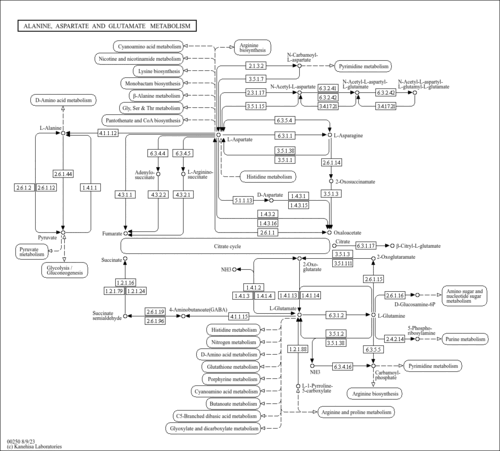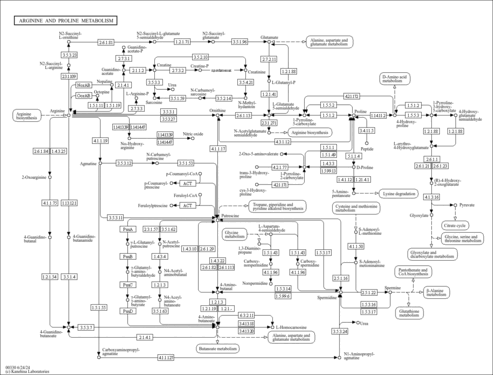| Record Information |
|---|
| Version | 1.0 |
|---|
| Created at | 2020-04-17 19:10:07 UTC |
|---|
| Updated at | 2020-12-07 19:11:36 UTC |
|---|
| CannabisDB ID | CDB005108 |
|---|
| Secondary Accession Numbers | Not Available |
|---|
| Cannabis Compound Identification |
|---|
| Common Name | 1-Pyrroline-5-carboxylic acid |
|---|
| Description | 1-Pyrroline-5-carboxylic acid, also known as delta(1)-pyrroline-5-carboxylate, belongs to the class of organic compounds known as alpha amino acids and derivatives. These are amino acids in which the amino group is attached to the carbon atom immediately adjacent to the carboxylate group (alpha carbon), or a derivative thereof. A 1-pyrrolinecarboxylic acid that is 1-pyrroline in which one of the hydrogens at position 5 is replaced by a carboxy group. 1-Pyrroline-5-carboxylic acid is a very strong basic compound (based on its pKa). 1-Pyrroline-5-carboxylic acid exists in all living species, ranging from bacteria to humans. Within humans, 1-pyrroline-5-carboxylic acid participates in a number of enzymatic reactions. In particular, 1-pyrroline-5-carboxylic acid can be converted into L-glutamic acid through the action of the enzyme Delta-1-pyrroline-5-carboxylate dehydrogenase, mitochondrial. In addition, 1-pyrroline-5-carboxylic acid can be converted into L-proline through the action of the enzyme proline dehydrogenase 1, mitochondrial. In humans, 1-pyrroline-5-carboxylic acid is involved in the metabolic disorder called hyperprolinemia type II. 1-Pyrroline-5-carboxylic acid is a potentially toxic compound. 1-Pyrroline-5-carboxylic acid is expected to be in Cannabis as all living plants are known to produce and metabolize it. |
|---|
| Structure | |
|---|
| Synonyms | | Value | Source |
|---|
| 3,4-Dihydro-2H-pyrrole-2-carboxylate | ChEBI | | Delta(1)-Pyrroline-5-carboxylic acid | ChEBI | | 3,4-Dihydro-2H-pyrrole-2-carboxylic acid | Generator | | delta(1)-Pyrroline-5-carboxylate | Generator | | Δ(1)-pyrroline-5-carboxylate | Generator | | Δ(1)-pyrroline-5-carboxylic acid | Generator | | 1-Pyrroline-5-carboxylate | Generator | | delta(1)Pyrroline-5-carboxylate | HMDB | | delta-1-Pyrroline-5-carboxylate, 14C-labeled, (+-)-isomer | HMDB | | Pyrroline-5-carboxylate | HMDB | | delta-1-Pyrroline-5-carboxylate | HMDB | | delta-1-Pyrroline-5-carboxylate, (+-)-isomer | HMDB | | delta-1-Pyrroline-5-carboxylic acid | HMDB | | (S)-1-Pyrroline-5-carboxylate | HMDB | | D1-Pyrroline-5-carboxylate | HMDB | | D1-Pyrroline-5-carboxylic acid | HMDB | | DL-1-Pyrroline-5-carboxylate | HMDB | | DL-1-Pyrroline-5-carboxylic acid | HMDB | | L-1-Pyrroline-5-carboxylate | HMDB | | L-delta 1-Pyrroline-5-carboxylate | HMDB | | Pyrroline 5-carboxylate | HMDB |
|
|---|
| Chemical Formula | C5H7NO2 |
|---|
| Average Molecular Weight | 113.11 |
|---|
| Monoisotopic Molecular Weight | 113.0477 |
|---|
| IUPAC Name | 3,4-dihydro-2H-pyrrole-2-carboxylic acid |
|---|
| Traditional Name | 1-pyrroline-5-carboxylic acid |
|---|
| CAS Registry Number | 2906-39-0 |
|---|
| SMILES | OC(=O)C1CCC=N1 |
|---|
| InChI Identifier | InChI=1S/C5H7NO2/c7-5(8)4-2-1-3-6-4/h3-4H,1-2H2,(H,7,8) |
|---|
| InChI Key | DWAKNKKXGALPNW-UHFFFAOYSA-N |
|---|
| Chemical Taxonomy |
|---|
| Description | Belongs to the class of organic compounds known as alpha amino acids and derivatives. These are amino acids in which the amino group is attached to the carbon atom immediately adjacent to the carboxylate group (alpha carbon), or a derivative thereof. |
|---|
| Kingdom | Organic compounds |
|---|
| Super Class | Organic acids and derivatives |
|---|
| Class | Carboxylic acids and derivatives |
|---|
| Sub Class | Amino acids, peptides, and analogues |
|---|
| Direct Parent | Alpha amino acids and derivatives |
|---|
| Alternative Parents | |
|---|
| Substituents | - Alpha-amino acid or derivatives
- Pyrroline carboxylic acid
- Pyrroline carboxylic acid or derivatives
- Pyrroline
- Carboxylic acid
- Monocarboxylic acid or derivatives
- Propargyl-type 1,3-dipolar organic compound
- Organic 1,3-dipolar compound
- Organoheterocyclic compound
- Azacycle
- Organopnictogen compound
- Organic oxygen compound
- Organooxygen compound
- Organonitrogen compound
- Organic oxide
- Carbonyl group
- Imine
- Organic nitrogen compound
- Hydrocarbon derivative
- Aliphatic heteromonocyclic compound
|
|---|
| Molecular Framework | Aliphatic heteromonocyclic compounds |
|---|
| External Descriptors | |
|---|
| Ontology |
|---|
|
| Disposition | Source: Biological location: |
|---|
| Role | Indirect biological role: |
|---|
| Physical Properties |
|---|
| State | Solid |
|---|
| Experimental Properties | | Property | Value | Reference |
|---|
| Melting Point | Not Available | Not Available | | Boiling Point | Not Available | Not Available | | Water Solubility | Not Available | Not Available | | logP | Not Available | Not Available |
|
|---|
| Predicted Properties | [] |
|---|
| EI-MS/GC-MS | | Type | Description | Splash Key | View |
|---|
| Predicted GC-MS | 1-Pyrroline-5-carboxylic acid, non-derivatized, Predicted GC-MS Spectrum - 70eV, Positive | splash10-00mo-9000000000-8ab2bc6c045679da1664 | Spectrum | | Predicted GC-MS | 1-Pyrroline-5-carboxylic acid, 1 TMS, Predicted GC-MS Spectrum - 70eV, Positive | splash10-014i-9100000000-34b6b42e5a9e4ff8715f | Spectrum |
|
|---|
| MS/MS | | Type | Description | Splash Key | View |
|---|
| MS/MS | LC-MS/MS Spectrum - QqQ 20V, positive | splash10-014i-9000000000-97191b38aeb79930b720 | 2020-07-21 | View Spectrum | | Predicted MS/MS | Predicted LC-MS/MS Spectrum - 10V, Positive | splash10-03dj-9700000000-f2bc2275638f96dc74ac | 2015-09-15 | View Spectrum | | Predicted MS/MS | Predicted LC-MS/MS Spectrum - 20V, Positive | splash10-014i-9100000000-72dff6639c24448bec9c | 2015-09-15 | View Spectrum | | Predicted MS/MS | Predicted LC-MS/MS Spectrum - 40V, Positive | splash10-014l-9000000000-28eb1358005b28459deb | 2015-09-15 | View Spectrum | | Predicted MS/MS | Predicted LC-MS/MS Spectrum - 10V, Negative | splash10-03di-5900000000-0720aa91caee03b9364e | 2015-09-15 | View Spectrum | | Predicted MS/MS | Predicted LC-MS/MS Spectrum - 20V, Negative | splash10-02t9-9400000000-cfcc87863f675fb12691 | 2015-09-15 | View Spectrum | | Predicted MS/MS | Predicted LC-MS/MS Spectrum - 40V, Negative | splash10-00kf-9000000000-a15b91c200295166bf9e | 2015-09-15 | View Spectrum |
|
|---|

